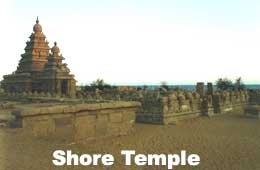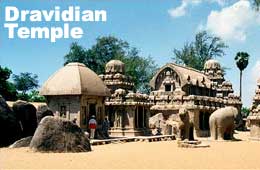| India Profile » Monuments and Temples in India » Shore Temple | |
Shore Temple | |
 | |
 Mamallapuram was once a port city of the Pallava rulers, located 50 km from the south of Chennai on the shores of Bay of Bengal. The temples and rock cut sculptures of that period create a unique blend of history and natural beauty. The monuments of Mamallapuram are excellent specimen of Dravidian temple architecture and Pallava art. The Shore temples at Mamallapuram were built during the reign of Rajasimha in the 7th century AD. The Shore temples are the example of zenith of the Pallava art and architecture. The temple is perched on a rocky outcrop and presides over the shoreline. Percy Brown has remarked that it served as 'a landmark by day and a beacon by night'. It was designed to catch the first rays of the rising sun and to illuminate the waters after dark. Thus the temple has an unusual layout. Rajasimha who ascended the throne in AD 674 built the Shore Temple. The Shore Temple was the first Pallava structure to be built of stone rather than being hewn out of stone like the older temples. The greatest improvement in design is in the shikhara or spire, which has altered from the rounded vihara design to a soaring, tiered style. Elements like the vimana or spire, the gopuram or gateway and animal figures that were to become trademark features of Dravidian architecture can all be seen here. And it is largely the use of dressed stone, which gave the architects greater creative freedom.
The main shrine faces the sea on the east and the gateway, the forecourt and the assembly hall of the Shore Temple lie behind the sanctum. The temple has shrines to both Lord Shiva and Lord Vishnu. The main sanctum and one of the two lesser ones on the west are dedicated to the Shiva. The enclosing wall has a series of Nandi bulls on it. Interconnected cisterns around the temple meant that the sea could be let in to transform the temple into a water shrine. A stone wall as been added to protect the shrine from the rising seas and further erosion in the recent times. These temples are refreshingly uncluttered, unlike later grandiose Dravidian architecture. The enclosure features two shrines that honor Shiva, facing Eastern and Western directions; superimposed between these two is a third shrine that honors Vishnu, as preserver of the Universe. He is depicted reclining on the serpent Sesha, a Hindu symbol for consciousness. The art in the sculpted panels of the temple laid emphasis on robust earthly beauties, imbibed with life. The sculptures are breathtakingly real and artistic. The Pallavas were followers of Jainism but the conversion of Mahendra Varman to Shaivism had drastic consequences on the future of Jainism and it also explains the Shiva and the Vishnu temple at Mamallapuram. The Shore temple is not a living temple. It is speculated that this edifice was constructed essentially as a work of art rather than as a place of worship. The Pallavas who built this temple were great patrons of the arts and were very influential in their distinctive character of temple architecture. The lion was a prominent symbol of their regime. The Shore temple is listed in the UNESCO World Heritage Sites of India. |
|
 |
